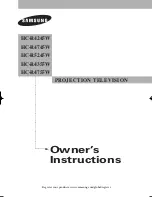
Creating Oscillographic Recordings for Tests
During commissioning, energization sequences should be carried out to check the stability of the protection
also during closing operations. Oscillographic event recordings contain the maximum information on the
behavior of the protection.
Along with the capability of storing fault recordings via pickup of the protection function, the 7SJ62/64 also
has the capability of capturing the same data when commands are given to the device via the service program
DIGSI, the serial interface, or a binary input. For the latter, event
>Trig.Wave.Cap.
must be allocated to a
binary input. Triggering for the oscillographic recording then occurs, for instance, via the binary input when
the protection object is energized.
An oscillographic recording that is triggered externally (that is, without a protective element pickup) are
processed by the device as a normal oscillographic record. For each oscillographic record a fault record is
created which is given its individual number to ensure that assignment can be made properly. However, these
oscillographic recordings are not displayed in the fault log buffer in the display as they are no network fault
events.
The procedure is described in detail in Chapter "Mounting and Commissioning".
Web Monitor
The Web Monitor facilitates the display of parameters, data and measuring values for SIPROTEC 4 devices
during installation or during operation. It uses Internet technology for this purpose. The display is effected by
means of a Web browser, e.g. the Internet Explorer.
The SIPROTEC Web Monitor provides a variety of comprehensive device functions, other available functions
are device-specific. For the 7SJ62/64, a phase diagram and an observation function for the illustration of
synchronization data are implemented as a specific functions. Apart from general information regarding instal-
lation, this manual provides a description of specific functions of the SIPROTEC Web Monitor for 7SJ62/64
only. The general functions are described in the Help file of the DIGSI-CD (as from DIGSI V4.60).
Prerequisites
The Web Monitor runs on the operator PC and requires only standard software. The following software
programs / operating systems must be installed:
Operating system: Microsoft Windows 7, Microsoft Windows XP, Microsoft Windows 2000, Microsoft Windows
NT, Microsoft Windows ME, Microsoft Windows 98
Internet browser: Netscape Communicator Version 4.7, Netscape Communicator as from Version 6.x or Micro-
soft Internet Explorer as from Version 5.0. Java must be installed and activated.
Web Monitor versions < V2.08 work with Java versions up to 6.xx. The Web Monitor version V2.09 supports
the Java version 7.xx and higher.
Long-distance data transmission network: The required software component is included in Microsoft
Windows 7, Microsoft Windows XP, Microsoft Windows 2000, Microsoft Windows NT and Windows 98. This
component is only required if the device is connected via a serial interface.
Network adapter: The required software component is included in Microsoft Microsoft Windows 7, Windows
XP, Microsoft Windows 2000, Microsoft Windows NT and Windows 98. This component is only required if the
device is connected via a serial interface (possible for devices with EN 100 interface).
General
During the commissioning phase, the device configuration created in the devices must be verified and their
functions be checked. The Web Monitor provides support during the basic and clear determination and
displaying of important measuring values.
Discrepancies in the wiring or the configuration can be quickly found and solved.
To run the Web Monitor, a link from the operator PC to the protection device via its front and rear operator
interface (service interface) is necessary. This can be done directly via the 9-pole DIGSI cable by means of an
existing long-distance data connection. Remote access via a modem is also possible. An Internet browser must
be installed on the operator PC (see paragraph on system requirements). DIGSI 4 is usually also installed on
the operator PC.
2.25.10
2.25.10.1
Functions
2.25 Auxiliary Functions
SIPROTEC 4, 7SJ62/64, Manual
341
C53000-G1140-C207-8, Edition 08.2016
Summary of Contents for SIPROTEC 4
Page 8: ...8 SIPROTEC 4 7SJ62 64 Manual C53000 G1140 C207 8 Edition 08 2016 ...
Page 18: ...18 SIPROTEC 4 7SJ62 64 Manual C53000 G1140 C207 8 Edition 08 2016 ...
Page 30: ...30 SIPROTEC 4 7SJ62 64 Manual C53000 G1140 C207 8 Edition 08 2016 ...
Page 540: ...540 SIPROTEC 4 7SJ62 64 Manual C53000 G1140 C207 8 Edition 08 2016 ...
Page 594: ...594 SIPROTEC 4 7SJ62 64 Manual C53000 G1140 C207 8 Edition 08 2016 ...
Page 720: ...720 SIPROTEC 4 7SJ62 64 Manual C53000 G1140 C207 8 Edition 08 2016 ...
















































